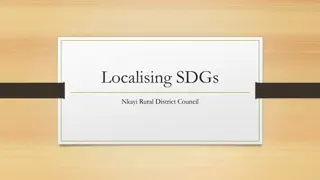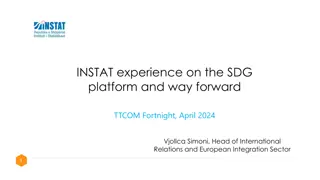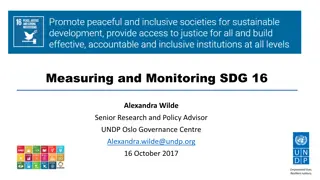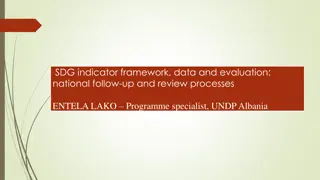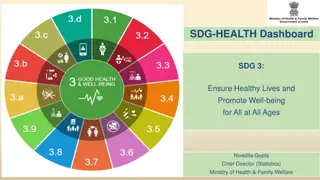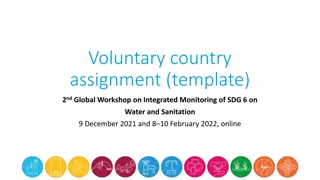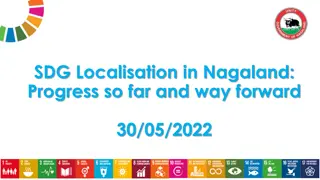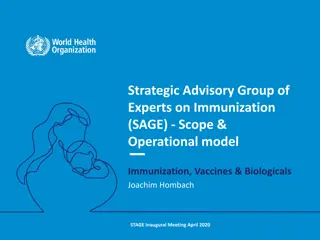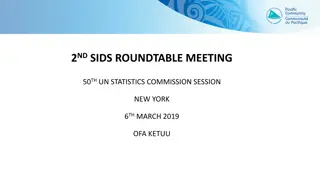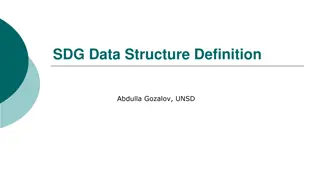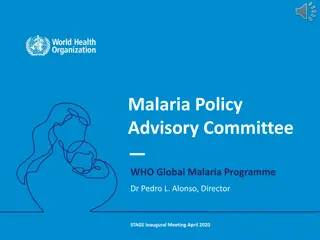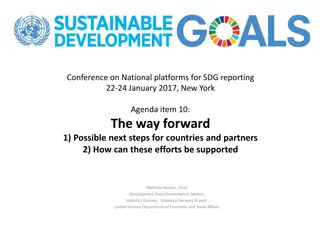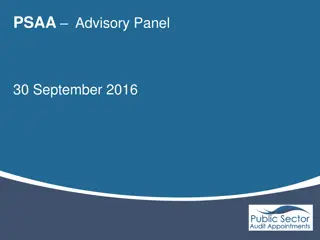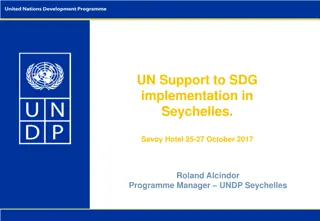Role of National SDG Advisory bodies
Explore the evolution and importance of national SDG advisory bodies in advancing sustainable development goals, focusing on multi-stakeholder partnerships and global cooperation. Learn how these bodies play a crucial role in mobilizing resources and knowledge to support the achievement of SDGs.
Download Presentation

Please find below an Image/Link to download the presentation.
The content on the website is provided AS IS for your information and personal use only. It may not be sold, licensed, or shared on other websites without obtaining consent from the author. Download presentation by click this link. If you encounter any issues during the download, it is possible that the publisher has removed the file from their server.
E N D
Presentation Transcript
Global Forum Network Meeting Role of National SDG Advisory bodies National Capacity Building Workshop on Voluntary Local Reviews (VLRs) in South Africa 27/28 March 2023
Introduction The Global Forum is a network that connects the knowledge and experience of multi-stakeholder advisory commissions, councils, and similar bodies for sustainable development. As a demand-driven network, it constantly evolves its focus on collective processes. With its rich pool of collective knowledge, the forum effectively invites stakeholders and governments around the globe to adapt, implement and jointly accelerate the delivery of the 2030 Agenda and the SDGs. This is the title The mission of the network is to co-create collective knowledge on sustainable development and transformation by creating room for cooperation, exchange, and peer learning across its membership. Thereby illustrating, with pilot initiatives and dialogue programmes, what options exist to deliver sustainable development. This is the sub-title
National SDG advisory bodies Journey 1992: The first wave of the national council for sustainable development was created around the time of the first Rio Earth Summit in Rio in 1992 2002: The Johannesburg Summit on Sustainable Development in 2002 reinvigorated this global movement. It was associated with creating a further wave of national strategies and National sustainable development councils. This is the title 2012: Rio+20 - Brought focus on multi-stakeholder partnerships to the fore and strengthened the national council for Sustainable development 2015: Agenda 2030 for sustainable development A new era for National SDG advisory bodies for SDG transformations This is the sub-title
National SDG advisory bodies Journey The 2030 Agenda identifies MSPs as a mechanism to help deliver the goals and targets in the SDGs and, more broadly, the commitments in the 2030 Agenda. This is reflected particularly in Goal 17, Strengthen the means of implementation and revitalise the global partnership for sustainable development , This is the title Target 17.16: Enhance the global partnership for sustainable development, complemented by multi-stakeholder partnerships that mobilise and share knowledge, expertise, technology and financial resources, to support the achievement of sustainable development goals in all countries, in particular developing countries. This is the sub-title
National SDG advisory bodies Journey On 20 December 2018, the General Assembly of the United Nations adopted the resolution Towards Global Partnerships: A Principle-Based Approach to Enhanced Cooperation between the United Nations and all Relevant Partners . . The resources, knowledge and ingenuity of all relevant stakeholders will be important in mobilising and sharing knowledge, expertise, technology and financial resources, complementing the efforts of governments and supporting the achievement of Sustainable Development Goals, in particular in developing countries. This is the title This is the sub-title
SDGs at the the halfway point Political effects of SDGs conceptualisation developed by Biermann et al. 2022, which looks at the steering effect of the SDGs, which is the political and societal response to the sustainable development goals and the degree to which sustainable development goals are achieved. This is the title The political and societal response in terms of institutional change, decision-making, political discourse, and resource allocation. This conceptualisation focuses on behavioural change of political, economic and social actors, specifically normative, institutional, discursive, relational and resource effects. This is the sub-title
SDGs at the the halfway point 2023 marks the mid-point of the implementation of the 2030 Agenda. The progress on implementation of the 2023 agenda over the last seven years has been slow and uneven, and the Covid pandemic has reversed the achievement of SDGs. This is the title The sustainable development goals report 2022 notes that the 2030 Agenda for Sustainable Development is in grave jeopardy due to multiple, cascading and intersecting crises. COVID-19, climate change and conflict predominate. This is the sub-title The UN secretary-general has called for an urgent rescue effort for the SDGs as a road map out of the crisis.
SDGs at the the halfway point The SDG summit scheduled for September 2023 will carry out a comprehensive review of the SDGs, respond to the impact of multiple and interlocking crises facing the world, and provide high-level political guidance on transformative and This is the title accelerated actions leading up to the target year of 2030 for achieving the SDGs. The High-Level Political Forum on Sustainable Development (HLPF), in July 2022, called for the Summit to mark the beginning of a new phase of accelerated progress towards the Sustainable Development Goals. This is the sub-title
SDGs at the the halfway point Ministerial declaration of the high-level segment of 2022 emphasised: that partnership will be critical to the achievement of the Sustainable Development Goals, as an effective instrument for mobilising additional human and financial resources, expertise, technology and knowledge. This is the title and notes included with the public and private sectors and partnerships with civil society to foster long-term strategic investment in the Sustainable Development Goals This is the sub-title
Status of SDG and NDP implementation 1) What actions have been taken on SDG implementation? What are some of the key success stories and bottlenecks (normative, institutional, discursive) South Africa has progressively aligned its national development framework with SDGs and introduced the SDG Coordination mechanism. This is the title It has set up an SDG coordination mechanism to strengthen the implementation of development policies and to review progress on the SDGs, the African Union s Agenda 2063, and the Southern African Development Community Regional Indicative Strategic Development Programme (SADC RISDP). The National Development Stakeholder Forum (NDSF) is a new feature of the coordinating mechanism. On the other hand, state and non-state actors have been engaged in developing a new social compact that lends a whole society approach toward development delivery. This is the sub-title
Status of SDG and NDP implementation According to Sustainable Development Report (2022), South Africa is on track with two SDG goals, namely gender equality (Goal 5) and Responsible production and consumption (Goal 12) There is modest progress on the six SDG goals (3; 6; 9; 11; 13;17) This is the title While progress has stalled on another Eight goals (Goal 2; 4; 7; 8; 10, 14; 15; 16) This is the sub-title Progress has been reversed on Goal 1 as poverty has increased in the last decade.
Status of SDG and NDP implementation In South Africa, the COVID-19 crisis has weakened an already fragile economy. South Africa's growth underperformed during the past decade: GDP per capita was lower in 2019 than in 2008. Unemployment remains high, around 35%, and youth unemployment exceeds 50%(OECD 2022). The economy has rebounded in 2021 by 4.9 per cent but remains below pre covid levels, and around 821 thousand fewer people were employed in Q2-2022 compared to Pre COVID levels. It is estimated that poverty rates (63.1 per cent in 2021 based on the upper middle-income poverty line) have climbed back to levels of more than a decade ago, and an additional 1.5 million people are poor relative to 2019 (world bank 2022). This is the title This is the sub-title
Status of SDG and NDP implementation 2) What are areas of priority action, and how have they been identified? Have the priority areas been aligned with local and regional budgets? VRN 2019 - priority action areas were identified This is the title The South African Economic Reconstruction and Recovery Plan- a renewed focus on new social contract Social compact The SDG Diagnostic Scoping Note This is the sub-title
Status of SDG and NDP implementation VRN 2019 - Priority action areas were identified include disaggregated data; addressing corruption; This is the title improving employment opportunities for the most vulnerable, discriminated sectors in society; eliminating gender inequalities and gender-based violence; and gauging the impact of the 4th Industrial Revolution. This is the sub-title Strengthening multi-stakeholder partnerships;
Status of SDG and NDP implementation 2022: The SDG Diagnostic Scoping Note has identified eights accelerators - Fast-tracked land reform at scale in both urban and rural areas of the country, This is the title Focused and sustained support for agriculture and agro-processing at scale, Strengthening, boosting and supporting the tourism sector at scale. Large-scale infrastructure investment, maintenance and upgrading, Expanding renewable energy generation and distribution at scale, This is the sub-title Expanding water capture, storage and distribution at scale, Post-graduate Youth service at scale, Establishing new and expanding and strengthening existing partnerships/compact
Role of SDGs advisory bodies MSP advisory bodies have long been recognised as forums for consensus-building on controversial issues and identifying practical, inclusive and socially acceptable solutions that will set the course for sustainable development. Diverse levels of institutionalisation characterise the current setting of the SDG advisory bodies within the SDGs context, varied participatory and consensus-building mechanisms, diverse organised stakeholder groups and organisational setup that actively supports SDGs in their respective countries. This is the title As the 2019 VNR report notes, daunting challenges remain to achieve progress on SDGs. The complex problem that the NDSF has to solve is thus the implementation challenge , which has been acknowledged by both state and non-state actors. This is the sub-title
Role of SDGs advisory bodies : why : why Progress on SDG transformations has been slow, and the country is not on track to achieve SDGs goals and targets by 2030 Implementation challenges, underpinned by Five key elements: Lack of Shared Understanding and Common Purpose Misalignment and differences in the Localisation of SDGs by Development Actors Lack of coordination among stakeholders Lack of effective mechanism to mobilise and direct resources from state and non-state actors Lack of inclusive monitoring and accountability mechanisms This is the title This is the sub-title
Role of SDGs advisory bodies: TOC Ensuring a shared understanding and common purpose Facilitating the increased alignment among stakeholders through the integration of the 2030 Agenda into planning processes and ensuring that the SDGs form part of the common development framework and language This is the title Providing knowledge brokering and policy advice Achieving coordinated and complementary effort This is the sub-title Instituting a collaboration and partnership platform to mobilise and direct resources Ensuring inclusive accountability,
Role of SDGs advisory bodies :The Function/Scope Multi-stakeholder dialogue towards shared understanding, common purpose Creating alignment among stakeholders through integrating the SDGs within a common framework and language for development discourse in South Africa This is the title To drive action through policy advice and knowledge brokering for the implementation of the SDGs. Establish SDG coordination and collaboration hub. This is the sub-title Monitoring and oversight, including the collating of data and statistics from the state and non-state actors
Status of SDG and NDP implementation 3. How have SDGs been integrated into local and regional development plans and strategies? 74% of SDG goals and targets are aligned with the SDGs, through consecutive medium-term development plans could increase alignment. This is the title it has been largely achieved through this medium-term strategic framework ( MTSF 2019-2024) We need to focus our attention. How SDGs are localised and integrated into the - Provincial Growth and Development Strategies This is the sub-title - Integrated Development Planning - One Plan- linked to the district development model
Status of SDG and NDP implementation 4. Why VLR can be a useful tool for enhancing SDGs implication in the local context - It brings the SDG review closer to service delivery and, of course, to communities - this is both important to inform the service delivery and to provide the platform with a certain level of accountability. it could open the local governments for review This is the title - Experiences from other countries show that - intergovernmental coordination (as well as multi-level governance and institutional organisation). It affects the distribution of resources, tasks and competencies across sub-national governments of all tiers. - Perhaps the largest impact that VLRs can have is at the local level, This is the sub-title - Opportunity for community-based organisation to participate - Human face of SDGs -
Status of SDG and NDP implementation 5. What will be the main benefits of the VLRs - Opportunity for bottom-up participation and inclusion - Responsive to the local context This is the title - Informed by citizen-generated data - local stories - locally-led development / Locally led adaptation/ Promotion of local solution This is the sub-title





